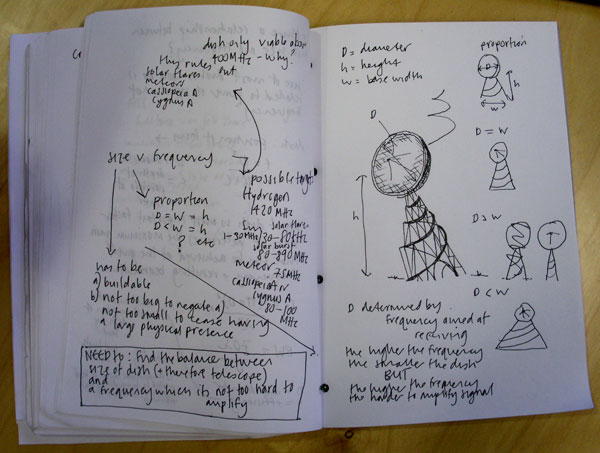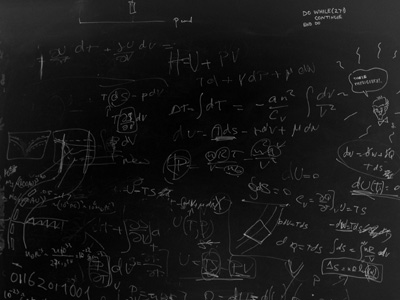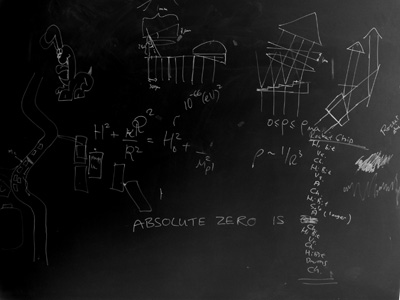September 28, 2004
H

As far as I understand it there's a balance between the size, the diameter, of a radio dish, and the frequencies it will pick up.
The higher frequencies are, the more difficult they are to amplify, so in the design of my telescope there is a trade off between building it not too large, not too small, yet not over complicating the task of amplifying the signal.
Furthermore there is no point just building it to pick up a convenient frequency. It needs to be aiming for a band in which something is going to be picked up. What this all means is that I need to find an interesting frequency that can be amplified without too much trouble, yet won't require an overly large dish.
Once this is sorted out the rest of the dimensions, the height and width of the tower, will be easy to work out. Then it's just a question of deciding on proportions, whether the diameter of the dish should be greater, equal or less than the width of the base of the tower, and by how much.
I need to confirm this but I read in some old notes that the diameter of the dish has to be approximately twice the wavelength. Thus a 5.2 meter diameter dish would pick up signals in the region of 2.6 meters wavelength, which in turn is a frequency of around 1420 Mhz*, the frequency of emissions of neutral hydrogen.
"after being excited, a neutral hydrogen atom will spontaneously decay, on average taking about 12 million years, and emit a photon with a frequency of 1420 Mhz". A long time to wait, but as there's so many there's always a potential dish full emitting a photon at any instant (if you point the dish in the right place).
What's the big deal about hydrogen ? As far as I can understand it hydrogen clouds represent the beginnings of structure in the universe - the point at which lone protons attract an electron in the particle soup of the early universe. Thus mapping clouds of hydrogen is akin to mapping the Cosmic Microwave Background, but later on in time. A billion years as opposed to three hundred thousand. Mapping concentrations of hydrogen, one sees where the density fluctuations are in the universe, the folds and wrinkles out of which emerged large scale structure.
*This is wrong. According to my calculations, the wavelength of 1420 Mhz is around 20 centimeters. So why would a 5.2 meter dish be used to detect hydrogen ? Certainly not because of the diameter = twice the wavelength theory. Don't know where I got this information from. If anyone understands the relationship between dish diameter and frequency I'd love to know !
Abundant Hydgrogen and the 21 cm line.
Jem has stumbled upon a key fact in Astronomy and Cosmology: Hydrogen is the most abundant element in the Universe. They way it is spread out in the Universe can tell us much about the structure and evolution of space and time. Hydrogen can be used like a coloured dye following the flows and eddies of matter as it collapses to form galaxies and clusters. It is the material from which the first stars are formed and it clumps around the heavy, dark mass of galaxies, moving under their gravitational pull.
Hydrogen has a very simple structure. It is made up of a negatively charged particle (the electron) and a positively charged, much heavier particle, the proton. The electrical force keeps them bound up, the electron zipping around under the pull of the proton. It is possible to supply enough energy to a hydrogen atom to strip the electron off the proton and what was once a neutral team (the negative charge of the electron cancelling the positive charge of the proton) becomes a charged pair. When the electron is pulled off the hydrogen atom we say that the hydrogen atom is ionized.
There is another more subtle interaction in the hydrogen atom. Both the electron and the proton have an internal property known as spin. Spin is a result of quantum mechanics and does not have a true classical counterpart. Yet it is sometimes useful to think of it through an analogy: consider a ball which is spinning around an axis. There are two possible motions, either rotating to one side or rotating to the other. We can imagine the proton and electrons as being balls which are each spinning on their axis. It turns out that there is an energetic dependence due to the interaction between the spin of the electron with that of the proton. If they are both spinning in the same direction, the energy due to the interaction is larger than if they are spinning in opposite directions. The energy difference is incredibly small so that if an atom undergoes a transition from one of these states to another, it will send out a bundle of light with a wavelength of about 21 centimetres.
The emission of 21 centimetre radiation by a hydrogen atom is extremely weak, but we are helped by the fact that hydrogen is abundant throughout the universe. Hydrogen makes up about three quarters of all the stuff we see in the Universe. It is a result of a very rapid period of nuclear reactions when the Universe was but a few minutes old. At that time the Universe consisted of a soup of free protons and neutrons, a neutral nuclear particle which is very slightly heavier than a proton. As the Universe expanded, it cooled down and when it dropped to about a billion degrees, some of the protons started to convert to neutrons through radioactive decay. Furthermore, the protons started to hook up with neutrons to form heavier nuclei. For example, two protons and two neutrons all stuck together to form the nucleus of a helium atom. Three protons and three neutrons form the nucleus of a lithium atom.
And so on. During this brief but heady period, the nuclei of the lightest elements are formed leaving us with the rough proportions of elements we see today: approximately 74% in hydrogen, 24% in helium and 2% in all the rest. Hence hydrogen is massively abundant throughout space.
By looking at the 21 centimetre line, we can map how hydrogen is spread out in the Universe. For example if we look at a galaxy, we will see stars out to a certain distance from the center. They will taper off, but the hydrogen which is attracted by the gravitational pull of the galaxy may linger out to a much larger distance. By looking for the 21 cm lines we can trace out the size of the galaxy to well beyond where stars have run out. If we look at how this hydrogen is moving around, in the force field of the galaxy, we can say something about how strong that very same gravitational pull is. The faster the hydrogen is moving, the stronger the gravitational pull has to be, to reign it in. And so, once again, by looking at the 21 cm we can measure the speed at which the hydrogen is moving.
The wavelength of this particular process in the realm of radio waves. The telescope that Jem plans to build will be tuned to detect this unique signature, and with care it should be possible to map the shape of our Galaxy and beyond.


